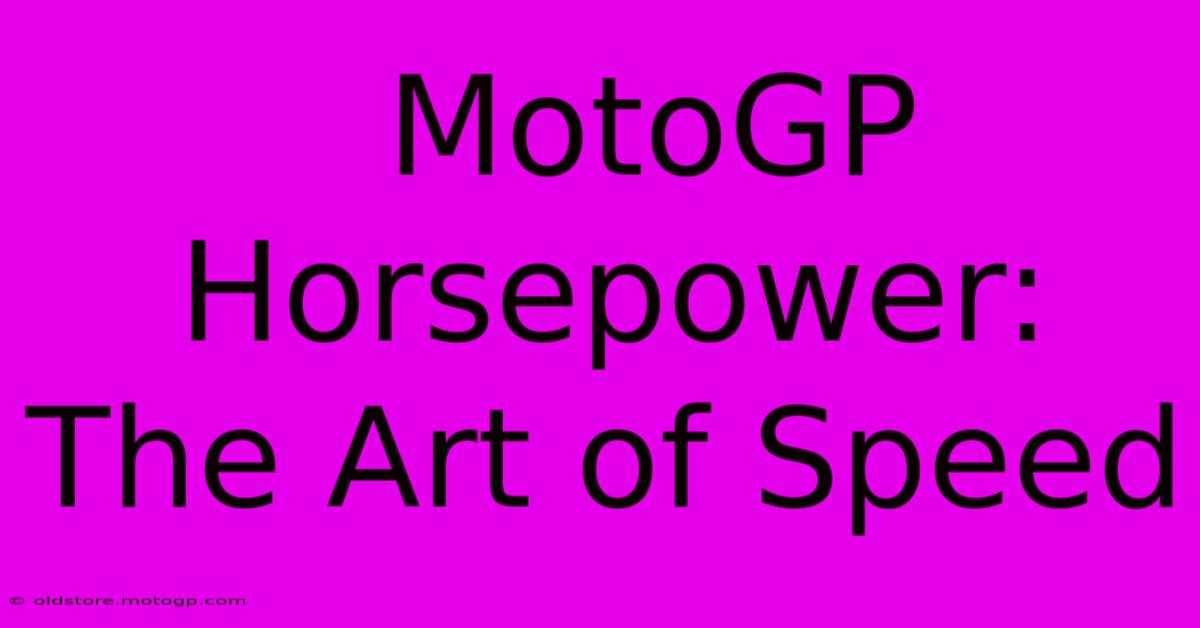MotoGP Horsepower: The Art Of Speed

Table of Contents
MotoGP Horsepower: The Art of Speed
MotoGP. The name alone conjures images of screaming engines, breathtaking speeds, and the ultimate test of rider skill. But what truly fuels this spectacle of speed? It's the phenomenal horsepower packed into these technologically advanced machines. This article delves into the world of MotoGP horsepower, exploring its evolution, the intricacies of its generation, and the crucial role it plays in the sport's thrilling drama.
The Raw Power: Horsepower Figures and Their Evolution
While precise horsepower figures are closely guarded secrets by manufacturers, it's widely accepted that modern MotoGP bikes produce over 260 horsepower. This isn't just raw power; it's finely tuned power, meticulously engineered to deliver peak performance across a wide range of engine speeds.
Historically, MotoGP horsepower has seen a dramatic increase. Early bikes were considerably less powerful, and the evolution reflects advancements in engine technology, materials science, and aerodynamic design. The transition from two-stroke engines to the current four-stroke configuration significantly impacted power delivery and overall horsepower output. The shift also allowed for greater refinement and controllability.
The Impact of Regulations
It's important to note that governing bodies, like the FIM (Fédération Internationale de Motocyclisme), implement regulations to maintain a degree of balance and prevent an excessive horsepower arms race. These regulations influence engine capacity, fuel flow, and other key parameters, shaping the horsepower characteristics of the bikes. This constant push and pull between technological innovation and regulatory constraints is a defining feature of MotoGP's development.
Beyond the Numbers: Engine Technology and Power Delivery
Horsepower is just one piece of the puzzle. The way that power is delivered is equally, if not more, crucial. MotoGP engines are masterpieces of engineering, incorporating cutting-edge technologies such as:
- Pneumatic valves: These advanced valve systems contribute to higher revving capabilities and improved power output.
- Sophisticated fuel injection systems: Precise fuel delivery ensures optimal combustion, maximizing horsepower while minimizing fuel consumption.
- Lightweight materials: The use of exotic materials like titanium and carbon fiber keeps the weight down, enabling superior acceleration and handling.
- Seamless gearboxes: Quick and precise gear changes are essential for maintaining speed and momentum, making the most of the engine's power.
- Aerodynamics: Aerodynamic design plays a vital role, reducing drag and enhancing stability at high speeds, allowing the engine's power to translate effectively into speed.
The Rider's Role: Harnessing the Beast
Even with all this technological marvel, the rider's skill is paramount. Controlling a machine capable of generating over 260 horsepower requires exceptional talent, precision, and courage. A rider's ability to manage throttle input, braking, and cornering directly affects how the horsepower is utilized on the track. The rider is essentially the conductor of this powerful symphony of engineering.
The Future of MotoGP Horsepower
The quest for greater horsepower continues. Manufacturers are constantly pushing the boundaries of engine technology, seeking incremental gains in performance. While regulations will likely continue to play a significant role, expect further advancements in areas such as fuel efficiency, engine mapping, and electronic control systems. This means that the pursuit of the ultimate MotoGP horsepower figure will be an ongoing chapter in the thrilling story of this demanding and exciting motorsport.
Keywords: MotoGP, Horsepower, MotoGP horsepower, Motorcycle racing, Engine technology, MotoGP bikes, FIM, Racing technology, Speed, Power, Motorcycle engines, Two-stroke, Four-stroke, Aerodynamics, Pneumatic valves, Fuel injection, Lightweight materials, Seamless gearboxes, Rider skill.

Thank you for visiting our website wich cover about MotoGP Horsepower: The Art Of Speed. We hope the information provided has been useful to you. Feel free to contact us if you have any questions or need further assistance. See you next time and dont miss to bookmark.
Featured Posts
-
Moto2 The Secrets Behind The Specs
Feb 24, 2025
-
Qualifying Chaos Unexpected F1 Grid Shakeup
Feb 24, 2025
-
Yamaha Moto Gp Racing The Importance Of Innovation
Feb 24, 2025
-
Yamaha Moto Gp The Role Of Sponsors
Feb 24, 2025
-
Moto 3 Motorcycle Inspiring The Next Generation Of Riders
Feb 24, 2025
